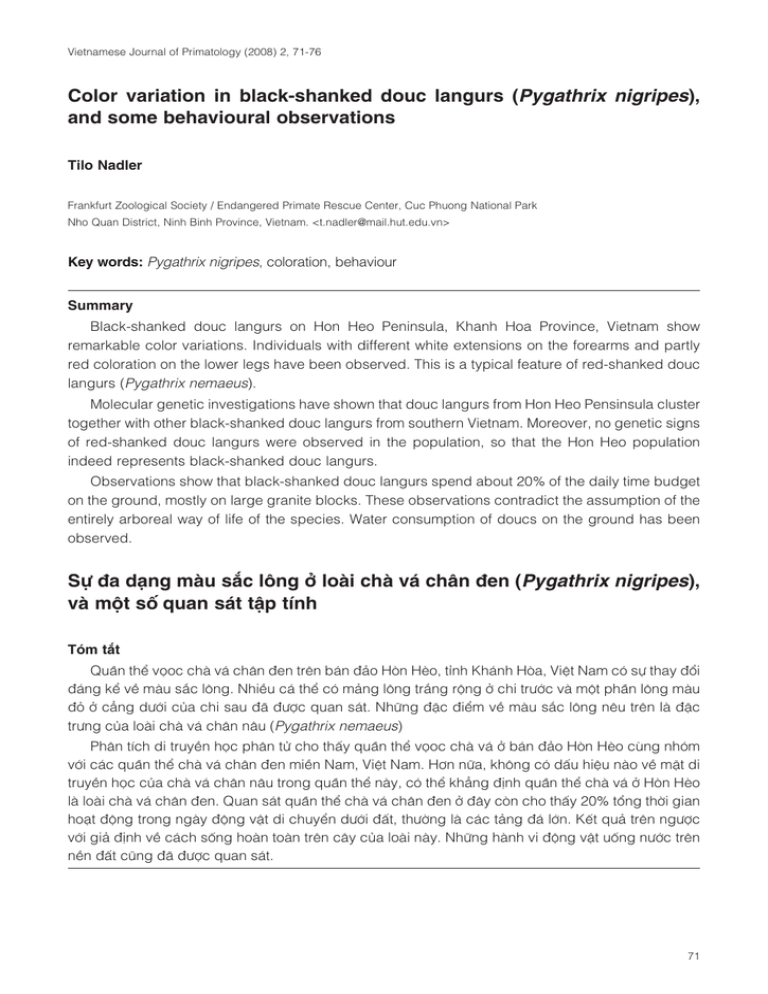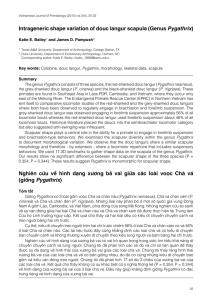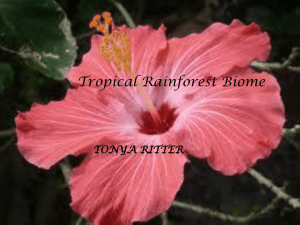Color variation in black-shanked douc langurs (Pygathrix nigripes
advertisement

Vietnamese Journal of Primatology (2008) 2, 71-76 Color variation in black-shanked douc langurs (Pygathrix nigripes), and some behavioural observations Tilo Nadler Frankfurt Zoological Society / Endangered Primate Rescue Center, Cuc Phuong National Park Nho Quan District, Ninh Binh Province, Vietnam. <t.nadler@mail.hut.edu.vn> Key words: Pygathrix nigripes, coloration, behaviour Summary Black-shanked douc langurs on Hon Heo Peninsula, Khanh Hoa Province, Vietnam show remarkable color variations. Individuals with different white extensions on the forearms and partly red coloration on the lower legs have been observed. This is a typical feature of red-shanked douc langurs (Pygathrix nemaeus). Molecular genetic investigations have shown that douc langurs from Hon Heo Pensinsula cluster together with other black-shanked douc langurs from southern Vietnam. Moreover, no genetic signs of red-shanked douc langurs were observed in the population, so that the Hon Heo population indeed represents black-shanked douc langurs. Observations show that black-shanked douc langurs spend about 20% of the daily time budget on the ground, mostly on large granite blocks. These observations contradict the assumption of the entirely arboreal way of life of the species. Water consumption of doucs on the ground has been observed. S˘ Æa dπng mµu sæc l´ng Î loµi chµ v∏ ch©n Æen (Pygathrix nigripes), vµ mÈt sË quan s∏t tÀp t›nh T„m tæt Qu«n th” v‰oc chµ v∏ ch©n Æen tr™n b∏n Æ∂o Hfln HÃo, tÿnh Kh∏nh Hfla, Vi÷t Nam c„ s˘ thay ÆÊi Æ∏ng k” v“ mµu sæc l´ng. Nhi“u c∏ th” c„ m∂ng l´ng træng rÈng Î chi tr≠Ìc vµ mÈt ph«n l´ng mµu Æ· Î cºng d≠Ìi cÒa chi sau Æ∑ Æ≠Óc quan s∏t. Nh˜ng Æ∆c Æi”m v“ mµu sæc l´ng n™u tr™n lµ Æ∆c tr≠ng cÒa loµi chµ v∏ ch©n n©u (Pygathrix nemaeus) Ph©n t›ch di truy“n h‰c ph©n tˆ cho th†y qu«n th” v‰oc chµ v∏ Î b∏n Æ∂o Hfln HÃo cÔng nh„m vÌi c∏c qu«n th” chµ v∏ ch©n Æen mi“n Nam, Vi÷t Nam. H¨n n˜a, kh´ng c„ d†u hi÷u nµo v“ m∆t di truy“n h‰c cÒa chµ v∏ ch©n n©u trong qu«n th” nµy, c„ th” khºng Æfinh qu«n th” chµ v∏ Î Hfln HÃo lµ loµi chµ v∏ ch©n Æen. Quan s∏t qu«n th” chµ v∏ ch©n Æen Î Æ©y cfln cho th†y 20% tÊng thÍi gian hoπt ÆÈng trong ngµy ÆÈng vÀt di chuy”n d≠Ìi Ɔt, th≠Íng lµ c∏c t∂ng Æ∏ lÌn. K’t qu∂ tr™n ng≠Óc vÌi gi∂ Æfinh v“ c∏ch sËng hoµn toµn tr™n c©y cÒa loµi nµy. Nh˜ng hµnh vi ÆÈng vÀt uËng n≠Ìc tr™n n“n Ɔt cÚng Æ∑ Æ≠Óc quan s∏t. 71 Vietnamese Journal of Primatology (2008) 2, 71-76 Introduction Ongoing studies have recently been initiated on the black-shanked douc langur (Pygathrix nigripes), yet, compared to other Indochinese primates, the species is poorly studied. Such a dearth of knowledge about Pygathrix nigripes has contributed to its provisional systematic placement as a subspecies within the red-shanked douc langur Pygathrix nemaeus (Chaplin & Jablonski, 1998; Lippold, 1998) and its incorrect assignment of “already extinct” (Warhol & Benirschke, 1986). The coloration of the black-shanked douc langur was initially described based on a few museum specimens and it is this description that has appeared in several publications (Jablonski, 1995; Lippold, 1998; Napier, 1985; Napier & Napier, 1997). With the intensified field work on primates in Vietnam and with the information from poached, confiscated and kept animals there is more detailed knowledge about this species which provides new insights. Material In May 2007 a survey was carried out on Hon Heo Peninsula, Khanh Hoa Province, south Vietnam (Ha Thang Long & Nadler, 2007) to gather an overview about a recently discovered population of black-shanked douc langurs (S. Lamarche, pers. comm.). During several additional visits to Hon Heo Peninsula douc langurs were observed with binoculars and documented with photographs and video. Fecal samples of 16 individuals were collected and used for molecular genetic analyses. Results Coloration Detailed observations of the douc langurs were made on several occasions. A maximum of 32 different individuals was observed belonging to three groups. Twelve animals were identified as having coloration that didn’t match the typical “standard description” of the black-shanked douc langur body coloration: dark grey forearms, and black lower legs (Groves, 1970; Chaplin & Jablonski, 1998; Fig. 1). Two typical features of different coloration could be recognized: 1. White coloration of varying length on the forearms. White coloration can extend from small patches, like a wristwatch, to a complete white forearm (Fig. 4-6). Fig. 1. A group of black-shanked douc langurs in Nui Chua National Park with typical “standard coloration”. Photo: Le Khac Quyet. 2. Red coloration on the lower leg. The red can be differ from a red shine, resulted in a number off red colored hairs to dark red coloration to at least the half lower leg (Fig. 7). Both features are typical coloration for the red-shanked douc langur (Pygathrix nemaeus) (Groves, 1970, Chaplin & Jablonski, 1998). Pygathrix nigripes populations in Cambodia (B. Rawson, pers. comm.), and the Vietnamese National Parks Nam Cat Tien (G. Polet, pers. comm.; Nadler, pers. obs.) and Nui Chua (Hoang Minh 72 Nadler: Color variation in black-shanked douc langurs Fig. 2, 3. Black-shanked douc langur with typical “standard coloration”; Hon Heo Peninsula, Khanh Hoa Province. Photo: T. Nadler. Fig. 4. Black-shanked douc male with small white patch on the wrist and black lower legs; Hon Heo Peninsula, Khanh Hoa Province. Photo: T. Nadler. Fig. 5. Black-shanked douc male (middle) with more extended white patch on the wrist and black lower legs; Hon Heo Peninsula, Khanh Hoa Province. Photo: T. Nadler. Fig. 6. Black-shanked douc male with complete white fore arms and black lower legs; Hon Heo Peninsula, Khanh Hoa Province. Photo: T. Nadler. Fig. 7. Black-shanked douc male with complete white fore arms and dark red on lower legs; Hon Heo Peninsula, Khanh Hoa Province. Photo: T. Nadler. 73 Vietnamese Journal of Primatology (2008) 2, 71-76 Duc, pers. comm.) show the typical blackshanked coloration. Also poached animals from neighbouring Khanh Hoa Province (only 30 to 40 km from the Hon Heo Peninsula) show no different coloration (Fig. 8). Molecular genetics From all 16 fecal samples collected, the hypervariable region I of the mitochondrial Dloop was successfully amplified and sequenced. Based on phylogenetic tree reconstructions, all obtained sequences cluster significantly Fig. 8. Poached black-shanked douc langurs from Khanh Hoa Province. together with black-shanked douc langurs and Photo: FPD. not with red- or grey-shanked douc langurs. Haplotypes from the latter two were not observed in the population (Roos, unpubl.). Although only maternally inherited markers were analyzed, it seems highly unlikely that paternal–inherited markers would provide a different relationship, which might be explained by hybridization. However, to definitively exclude hybridization further markers should be analyzed. Behavioural observations Contrary to the assumption that doucs are entirely arboreal (Lippold, 1998; Napier & Napier, 1997) the black-shanked douc langurs on Hon Heo Peninsula spend about two hours per day (20% of the daily time budget) on the ground, seeming to prefer granite blocks for resting and social contact, like grooming and mating (Fig. 9-13). One reason to move to the ground is the need to drink water. A group of douc langurs was observed drinking extensively from a water source every morning (Fig. 14-15). Little is known about the water consumption of colobines and it is often overlooked that water is an essential nutrient (Committee of Animal Nutrition, 2003). Douc langurs have a relatively high water demand (Ruempler, 1998). This high demand exists not only for animals fed compressed food or pellets under captive conditions (Lippold, 1977). Observations on doucs at the EPRC, kept in cages and Fig. 9, 10. Black-shanked douc langurs resting on a granite block. Photo: T. Nadler. 74 Nadler: Color variation in black-shanked douc langurs Fig. 11, 12, 13. Female offered mating, laying down for mating, and mating. The male has a white wrist patch. Photo: T. Nadler. on a semi-wild area, show that doucs also drink extensive water when natural food is available (Nadler, unpubl.). In the wild doucs probably also use arboreal cisterns (such as depressions at junctures of tree limbs and trunks) as has been documented for mantled howlers (Alouatta palliata) (Glander, 1978), but doucs often form relatively large groups and therefore arboreal water sources are likely insufficient, necessitating animals to move to the ground to use terrestrial water sources. Fig. 14. Black-shanked douc langur group moved to a water hole on the top of a granite block. One male with an extended white patch on the wrist. Photo: T. Nadler. Fig. 15. Black-shanked douc langurs drinking from a water hole on the top of a granite block. Photo: T. Nadler. 75 Vietnamese Journal of Primatology (2008) 2, 71-76 The reason that field investigators previously had not seen douc langurs on the ground and drinking directly from water sources (Lippold, 1977; 1998) can be attributed to unhabituated animals exercising caution in the presence of observers. Acknowledgements Special thanks goes to Sylvio Lamarche who brought attention to the occurrence of the blackshanked douc langur population on Hon Heo Peninsula, for his commitment to conservation, his great support during all visits and his friendship. References Chaplin G & Jablonski NG (1998): The Integument of the “Odd-nosed” Colobines. In: Jablonski (ed.): The Natural History of Doucs and Snub-nosed Monkeys; pp. 79-104. World Scientific Publishing, Singapore. Committee of Animal Nutrition (2003): Nutrient Requirements of Nonhuman Primates. The National Academic Press, Washington DC. Glander KE (1978): Drinking from arboreal water sources by mantled howling monkeys (Alouatta palliata Gray). Folia Primatol. 29, 206-217. Groves CP (1970): Thwe forgotten Leaf-Eaters and the phyologeny of the Colobinae. In: Napier & Napier (eds.): Old World Monkeys; pp. 555-587. Academic Press, New York. Ha Thang Long & Nadler T (2007): Rapid assessment of the status of black-shanked doucs (Pygathrix nigripes) on Hon Heo Peninsula, Khanh Hoa Province. Report to Forest Inventory and Planning Institute, Hanoi and Frankfurt Zoological Society. Jablonski NG (1995): The phyletic position and sytematics of the douc langurs of Southeast Asia. Amer. J. Primatol. 35, 185-205. Lippold LK (1977(: The Douc Langur: A Time for Conservation. In: HSH Prince Rainier, GH Bourne (eds.): Primate Conservation; pp. 513-538. Academic Press, New York. Lippold LK (1998): Natural History of Douc Langurs. In: Jablonski (ed.): The Natural History of Doucs and Snub-nosed Monkeys; pp. 191-206. World Scientific Publishing, Singapore. Napier PH (1985): Catalogue of Primates in the British Museum (Natural History) and Elsewhere in the British Isles, Part 3: Family Cercopithecidae, Subfamily Colobinae. British Museum (Natural History), London. Napier JR & Napier PH (1997): The natural history of the primates. Walsworth Publishing. Ruempler U (1998): Husbandry and breeding of douc langurs (Pygathrix nemaeus nemaeus) at Cologne Zoo. Int. Zoo. Yb. 36,73-81. Warhol A & Benirschke K (1986): Vanishing Animals. Springer-Verlag, Berlin, Heidelberg, New York. 76


